
Visitors to London’s many green spaces would have to be stubbornly looking at their feet to not see one of the UK’s most exotic birds, parakeets. Dubbed “posh pigeons” by unimaginative Londoners, these brilliant green birds stand out among the fauna of northern Europe’s mostly grey cities.

‘Parakeets’ is actually an umbrella term referring to the multiple species, which can now be found in London, Amsterdam, Brussels, Paris and various German cities. By far the most common is the Indian ring-necked parakeet, easily recognisable by the stylish red ring around their neck, a matching red beak and, of course, the loud squawking.
In the last 50 years, these migrants from South Asia have arrived and thrived, settling into their own ecological niche. In the UK, London is a particular parakeet stronghold, but although they may have originally settled in the leafy streets of Twickenham, the birds can now be found in cities as far north as Glasgow.
One often reported theory is that the capital’s current population are the descendants of birds that escaped from Shepperton Studios during the filming of The African Queen, starring Humphrey Bogart and Katharine Hepburn. Others would tell you that they escaped from Syon Park in the early 1970s when a piece of debris from a passing aircraft damaged the aviary and allowed them to escape. This chimes with their original concentration in south-west London.
Another is that parakeets were released by Jimi Hendrix on London’s Carnaby Street in the late ’60s. Bored of London’s grey skyline, he set the little fellas free to liven up the place.
However they got here, from 1970 onwards their numbers boomed. In 1992, 700 birds were recorded in the London Bird Report. By 1998, 2,845 were seen in the London Area, and by 2006 the ring-neck parakeet was the 15th most sighted bird in London. BY 2022, some reports estimated the number at 32,000.
Parakeets in London
Darwin would be proud of how well they adapted to the new environment. Toughened up by the hard Himalayan climate, they handle the cold northern European winters better than most locals. Climate change is often brought up in discussions of the parakeets, but it is certainly only part of the story.
It helps, too, that the birds have a 35-year lifespan and few local predators, enabling them to breed freely.
As with any new species, the debate has raged about whether they are harmful to the ecosystem. Strangely reminiscent of the debate over human migrants, often the birds have been accused of stealing the homes of the natives. The parakeets do nest in tree cavities also used by jackdaws, owls and woodpeckers – but there is little evidence that native species are being muscled out.
They also provide a food source for the UK’s embattled birds of prey. Owls and peregrine falcons have been known to eat them.
Of more concern is the new arrivals’ effect on plants and trees. By 2009 their numbers in the UK had grown so much that they were added to the “general licence” of species, which can be killed without individual permission if they are causing damage.
Parrotnet, an EU-funded research project studying the development of parakeet populations across Europe, has warned of the risk they pose to agriculture. In their native India, the parakeets are known to cause widespread damage to crops. As agriculture develops in the UK in line with warmer climates, crops such as maize, grapes and sunflower will become more popular. In India, the birds have been documented as reducing maize crops by 81%.
So the parakeets remain divisive. Environmentalist Tony Juniper has disparagingly described them as “the grey squirrel of the skies”. By contrast, the University of York biologist Chris D Thomas has argued that the parakeets should be left free to move and breed. He sees those wary of the parakeet boom of “irrational persecution” of the bird.
For good or ill the parakeets in Londonare here to stay. As so often with migrants of all kinds, there has been some unease about the impact they have had – but the birds, popular among Londoners, certainly add colour to the city. Thriving in the urban environment thousands of miles from their natural habitat, they are a metropolitan bird for Europe’s metropolitan cities.
[Read more: The dedicated network of volunteers rescuing injured birds in New York]






